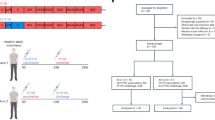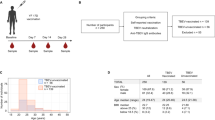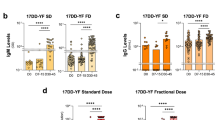Abstract
Vaccination has achieved remarkable successes in the control of childhood viral diseases. To control emerging infections, however, vaccines will need to be delivered to older individuals who, unlike infants, probably have had prior infection or vaccination with related viruses and thus have cross-reactive antibodies against the vaccines. Whether and how these cross-reactive antibodies impact live attenuated vaccination efficacy is unclear. Using an open-label randomized trial design, we show that subjects with a specific range of cross-reactive antibody titres from a prior inactivated Japanese encephalitis vaccination enhanced yellow fever (YF) immunogenicity upon YF vaccination. Enhancing titres of cross-reactive antibodies prolonged YF vaccine viraemia, provoked greater pro-inflammatory responses, and induced adhesion molecules intrinsic to the activating Fc-receptor signalling pathway, namely immune semaphorins, facilitating immune cell interactions and trafficking. Our findings clinically demonstrate antibody-enhanced infection and suggest that vaccine efficacy could be improved by exploiting cross-reactive antibodies.
This is a preview of subscription content, access via your institution
Access options
Subscribe to this journal
Receive 12 digital issues and online access to articles
$119.00 per year
only $9.92 per issue
Buy this article
- Purchase on SpringerLink
- Instant access to full article PDF
Prices may be subject to local taxes which are calculated during checkout





Similar content being viewed by others
References
Pike, B. L. et al. The origin and prevention of pandemics. Clin. Infect. Dis. 50, 1636–1640 (2010).
Fauci, A. S. & Morens, D. M. Zika virus in the Americas—yet another arbovirus threat. N. Engl. J. Med. 374, 601–604 (2016).
WHO Ebola Response Team. Ebola virus disease in West Africa—the first 9 months of the epidemic and forward projections. N. Engl. J. Med. 371, 1481–1495 (2014).
D'Argenio, D. A. & Wilson, C. B. A decade of vaccines: integrating immunology and vaccinology for rational vaccine design. Immunity 33, 437–440 (2010).
Rappuoli, R., Mandl, C. W., Black, S. & De Gregorio, E. Vaccines for the twenty-first century society. Nat. Rev. Immunol. 11, 865–872 (2011).
Henao-Restrepo, A. M. et al. Efficacy and effectiveness of an rVSV-vectored vaccine expressing Ebola surface glycoprotein: interim results from the Guinea ring vaccination cluster-randomised trial. Lancet 386, 857–866 (2015).
Buchbinder, S. P. et al. Efficacy assessment of a cell-mediated immunity HIV-1 vaccine (the Step Study): a double-blind, randomised, placebo-controlled, test-of-concept trial. Lancet 372, 1881–1893 (2008).
Davenport, F. M., Hennessy, A. V. & Francis, T. Jr Epidemiologic and immunologic significance of age distribution of antibody to antigenic variants of influenza virus. J. Exp. Med. 98, 641–656 (1953).
Hadinegoro, S. R. et al. Efficacy and long-term safety of a dengue vaccine in regions of endemic disease. N. Engl. J. Med. 373, 1195–1206 (2015).
Villar, L. et al. Efficacy of a tetravalent dengue vaccine in children in Latin America. N. Engl. J. Med. 372, 113–123 (2015).
Capeding, M. R. et al. Clinical efficacy and safety of a novel tetravalent dengue vaccine in healthy children in Asia: a phase 3, randomised, observer-masked, placebo-controlled trial. Lancet 384, 1358–1365 (2014).
Halstead, S. B., Mahalingam, S., Marovich, M. A., Ubol, S. & Mosser, D. M. Intrinsic antibody-dependent enhancement of microbial infection in macrophages: disease regulation by immune complexes. Lancet Infect. Dis. 10, 712–722 (2010).
Chan, K. R. et al. Leukocyte immunoglobulin-like receptor B1 is critical for antibody-dependent dengue. Proc. Natl Acad. Sci. USA 111, 2722–2727 (2014).
Boonnak, K., Dambach, K. M., Donofrio, G. C., Tassaneetrithep, B. & Marovich, M. A. Cell type specificity and host genetic polymorphisms influence antibody-dependent enhancement of dengue virus infection. J. Virol. 85, 1671–1683 (2011).
Campi-Azevedo, A. C. et al. Subdoses of 17DD yellow fever vaccine elicit equivalent virological/immunological kinetics timeline. BMC Infect. Dis. 14, 391 (2014).
Subramanian, A. et al. Gene set enrichment analysis: a knowledge-based approach for interpreting genome-wide expression profiles. Proc. Natl Acad. Sci. USA 102, 15545–15550 (2005).
Gaucher, D. et al. Yellow fever vaccine induces integrated multilineage and polyfunctional immune responses. J. Exp. Med. 205, 3119–3131 (2008).
Querec, T. D. et al. Systems biology approach predicts immunogenicity of the yellow fever vaccine in humans. Nat. Immunol. 10, 116–125 (2009).
McKinney, E. F., Lee, J. C., Jayne, D. R., Lyons, P. A. & Smith, K. G. T-cell exhaustion, co-stimulation and clinical outcome in autoimmunity and infection. Nature 523, 612–616 (2015).
Acuto, O. & Michel, F. CD28-mediated co-stimulation: a quantitative support for TCR signalling. Nat. Rev. Immunol. 3, 939–951 (2003).
Boyman, O. & Sprent, J. The role of interleukin-2 during homeostasis and activation of the immune system. Nat. Rev. Immunol. 12, 180–190 (2012).
Suzuki, K., Kumanogoh, A. & Kikutani, H. Semaphorins and their receptors in immune cell interactions. Nat. Immunol. 9, 17–23 (2008).
Takamatsu, H. & Kumanogoh, A. Diverse roles for semaphorin-plexin signaling in the immune system. Trends Immunol. 33, 127–135 (2012).
Kolodkin, A. L., Matthes, D. J. & Goodman, C. S. The semaphorin genes encode a family of transmembrane and secreted growth cone guidance molecules. Cell 75, 1389–1399 (1993).
Kumanogoh, A. et al. Class IV semaphorin Sema4A enhances T-cell activation and interacts with Tim-2. Nature 419, 629–633 (2002).
Suzuki, K. et al. Semaphorin 7A initiates T-cell-mediated inflammatory responses through α1β1 integrin. Nature 446, 680–684 (2007).
van Rijn, A. et al. Semaphorin 7A promotes chemokine-driven dendritic cell migration. J. Immunol. 196, 459–468 (2016).
Daynes, R. A., Dowell, T. & Araneo, B. A. Platelet-derived growth factor is a potent biologic response modifier of T cells. J. Exp. Med. 174, 1323–1333 (1991).
Gavalas, N. G. et al. VEGF directly suppresses activation of T cells from ascites secondary to ovarian cancer via VEGF receptor type 2. Br. J. Cancer 107, 1869–1875 (2012).
Ziogas, A. C. et al. VEGF directly suppresses activation of T cells from ovarian cancer patients and healthy individuals via VEGF receptor Type 2. Int. J. Cancer 130, 857–864 (2012).
Liu, Y. et al. Regulated expression of FcgammaR in human dendritic cells controls cross-presentation of antigen-antibody complexes. J. Immunol. 177, 8440–8447 (2006).
Guzman, M. G. et al. Dengue hemorrhagic fever in Cuba, 1981: a retrospective seroepidemiologic study. Am. J. Trop. Med. Hyg. 42, 179–184 (1990).
de Alwis, R. et al. Dengue viruses are enhanced by distinct populations of serotype cross-reactive antibodies in human immune sera. PLoS Pathogens 10, e1004386 (2014).
Halstead, S. B. & O'Rourke, E. J. Dengue viruses and mononuclear phagocytes. I. Infection enhancement by non-neutralizing antibody. J. Exp. Med. 146, 201–217 (1977).
Olkowski, S. et al. Reduced risk of disease during postsecondary dengue virus infections. J. Infect. Dis. 208, 1026–1033 (2013).
Thanachartwet, V. et al. Identification of clinical factors associated with severe dengue among Thai adults: a prospective study. BMC Infect. Dis. 15, 420 (2015).
Ben Mkaddem, S. et al. Shifting FcγRIIA-ITAM from activation to inhibitory conFig.uration ameliorates arthritis. J. Clin. Invest. 124, 3945–3959 (2014).
Aloulou, M. et al. IgG1 and IVIg induce inhibitory ITAM signaling through FcγRIII controlling inflammatory responses. Blood 119, 3084–3096 (2012).
Chan, K. R. et al. Ligation of Fc γ receptor IIB inhibits antibody-dependent enhancement of dengue virus infection. Proc. Natl Acad. Sci. USA 108, 12479–12484 (2011).
Lennartz, M. R. & Brown, E. J. Arachidonic acid is essential for IgG Fc receptor-mediated phagocytosis by human monocytes. J. Immunol. 147, 621–626 (1991).
Stachowska, E. et al. Conjugated linoleic acids can change phagocytosis of human monocytes/macrophages by reduction in Cox-2 expression. Lipids 42, 707–716 (2007).
Middleton, M. K., Rubinstein, T. & Pure, E. Cellular and molecular mechanisms of the selective regulation of IL-12 production by 12/15-lipoxygenase. J. Immunol. 176, 265–274 (2006).
Calder, P. C. & Grimble, R. F. Polyunsaturated fatty acids, inflammation and immunity. Eur. J. Clin. Nutr. 56(Suppl. 3), S14–S19 (2002).
Pulendran, B. Systems vaccinology: probing humanity's diverse immune systems with vaccines. Proc. Natl Acad. Sci. USA 111, 12300–12306 (2014).
Casanova, J. L. & Abel, L. The genetic theory of infectious diseases: a brief history and selected illustrations. Annu. Rev. Genom. Hum. Genet. 14, 215–243 (2013).
Kau, A. L., Ahern, P. P., Griffin, N. W., Goodman, A. L. & Gordon, J. I. Human nutrition, the gut microbiome and the immune system. Nature 474, 327–336 (2011).
Goh, K. C. et al. Molecular determinants of plaque size as an indicator of dengue virus attenuation. Sci. Rep. 6, 26100 (2016).
Jafari, H. et al. Polio eradication. Efficacy of inactivated poliovirus vaccine in India. Science 345, 922–925 (2014).
Bass, J. W. et al. Booster vaccination with further live attenuated measles vaccine. JAMA 235, 31–34 (1976).
Low, J. G. et al. The role of pre-existing cross-reactive antibodies in determining the efficacy of vaccination in humans: study protocol for a randomized controlled trial. Trials 16, 147 (2015).
Domingo, C. et al. Advanced yellow fever virus genome detection in point-of-care facilities and reference laboratories. J. Clin. Microbiol. 50, 4054–4060 (2012).
Cui, L. et al. Serum metabolome and lipidome changes in adult patients with primary dengue infection. PLoS Negl. Trop. Dis. 7, e2373 (2013).
Hanson, B. J. et al. Passive immunoprophylaxis and therapy with humanized monoclonal antibody specific for influenza A H5 hemagglutinin in mice. Respir. Res. 7, 126 (2006).
Acknowledgements
The authors thank C. Chua for technical assistance and also thank the research coordinators and nurses, G.K.Y. Li, E.Y.L. Lim and A.K.L. Shum. The authors thank E. Ong for her constructive review of this work. This work is supported by the Translational Clinical Research Programme of the Biomedical Research Council of Singapore. Y.B.C. was supported by the National Research Foundation, Singapore, under its Clinician Scientist Award (award no. NMRC/CSA/039/2012) administered by the Singapore Ministry of Health's National Medical Research Council.
Author information
Authors and Affiliations
Contributions
K.R.C., J.G.H.L., S.N.A. and E.E.O. conceptualized and designed the study. J.G.H.L., L.W. and X.W. enrolled the subjects of the trial. K.R.C., H.C.T., X.W., E.S.G. and D.Z.L.M. performed the biochemical and in vitro experiments. C.L. and Y.H.L. performed the lipid and cytokine profiling. K.R.C., E.S.G. and S.G. performed the transcriptomic analysis. S.L.-X.Z. generated and characterized the primary dendritic cells. W.A.A.S. and A.L.S. designed and performed the mouse experiments. Y.B.C. designed the clinical trial and performed the data analysis methods and interpretation. K.R.C., J.G.H.L., Y.H.L., S.R.T., Y.B.C., A.L.S., S.N.A. and E.E.O. analysed the data. K.R.C. and E.E.O. wrote the first version of the manuscript. K.R.C., J.G.H.L., Y.H.L., Y.B.C., A.L.S., S.N.A. and E.E.O. reviewed and revised the manuscript.
Corresponding authors
Ethics declarations
Competing interests
The authors declare no competing financial interests.
Supplementary information
Supplementary information
Supplementary Figures 1–7, Supplementary Tables 1–6 (PDF 4697 kb)
Rights and permissions
About this article
Cite this article
Chan, K., Wang, X., Saron, W. et al. Cross-reactive antibodies enhance live attenuated virus infection for increased immunogenicity. Nat Microbiol 1, 16164 (2016). https://doi.org/10.1038/nmicrobiol.2016.164
Received:
Accepted:
Published:
DOI: https://doi.org/10.1038/nmicrobiol.2016.164
This article is cited by
-
Electron transport chain capacity expands yellow fever vaccine immunogenicity
EMBO Molecular Medicine (2024)
-
Immune gene expression analysis indicates the potential of a self-amplifying Covid-19 mRNA vaccine
npj Vaccines (2022)
-
A perspective on potential antibody-dependent enhancement of SARS-CoV-2
Nature (2020)
-
Mimicking immune signatures of flavivirus infection with targeted adjuvants improves dengue subunit vaccine immunogenicity
npj Vaccines (2019)
-
Pre-existing yellow fever immunity impairs and modulates the antibody response to tick-borne encephalitis vaccination
npj Vaccines (2019)



